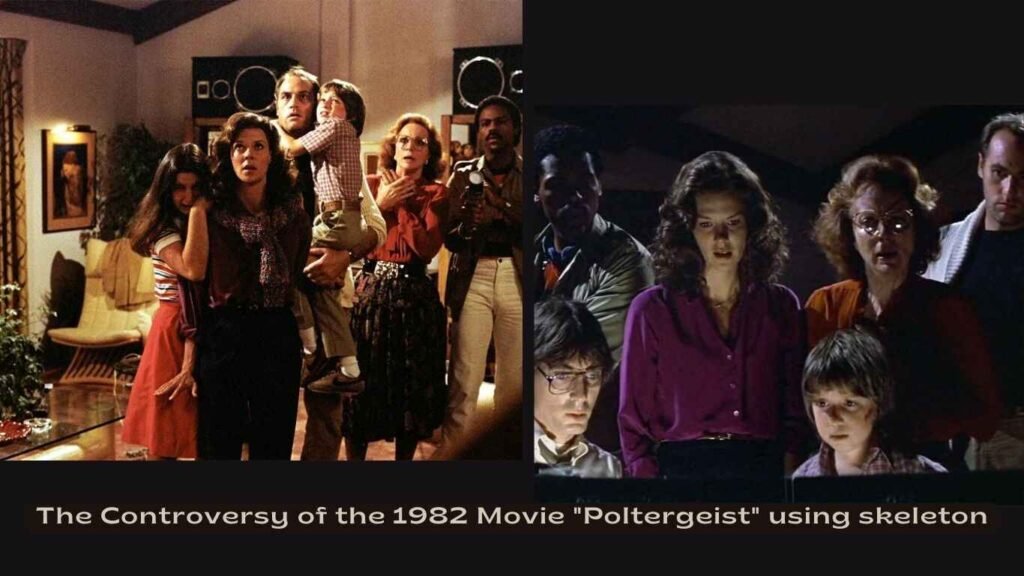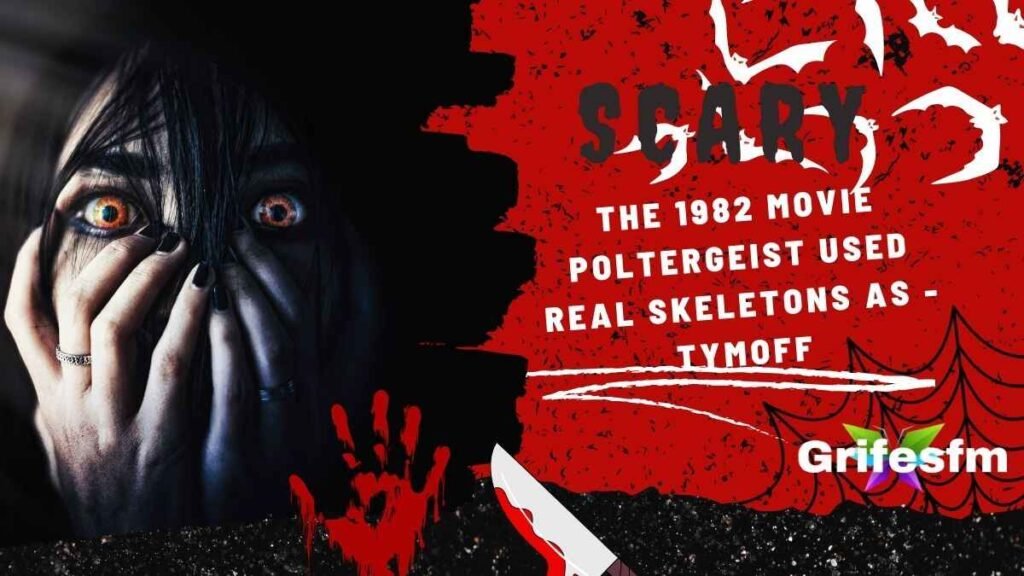Flat out amazing is what I would say, that ignorance was bliss when you hear something like “Poltergeist” for example used real human skeletons as props! This revelation gives the whole movie a very disturbing touch and raises some question about the studies of filmmaking. “Poltergeist”, directed by Tobe Hooper and produced by Steven Spielberg, was already leaving its mark when the Berwyn film released a year earlier. You may not have liked the plot but the special effects were effective. The story progress well and the creepiness was felt throughout the movie. But knowing they utilized real bones, I loved the film and could not help but notice its profound social implications. That’s what puts everyone in a question about what is okay to do while producing art and still remain ethical. In this article we will explore more about The 1982 Movie Poltergeist used real skeletons as – tymoff
The History of the The 1982 Movie Poltergeist used real skeletons as – tymoff
Word got around after Poltergeist came out that Siegel really did use real human bones to film certain shots during production, such as the scene with the pool. That caused much demand and speculation regarding the movie from both fans and movie critics. Similar to the movie where the events turned from a horror story about an entity haunting a family’s house to discussing the morality of the action. The incident became surrounded by ethical considerations.
Revealing the Reality Regarding the Real Skeletons
Suburban horror and queering the supernatural in ‘Poltergeist’ In between the presentation of fear, which can associated with the suburban setting, and otherworldly actors of the film, there is quite a disturbing fact that actual human skeletons were utilized for shooting. This choice is of greatly emphasis in the dynamic pool scene exercise where JoBeth Williams persona has to confront diverse spirits. This meant that specific visuals require by the production team had to worth it combined with an extremely limited budget. The production team rather use human skeletons as opposed to fake ones. Even though this was not an exception in the filmmaking process during the specified era. It raised a rather massive stir for several reasons including the popularity of the film.
The Uncovered Proof
While the assertion that ‘Poltergeist’ used real skeletons is yet to conclusively substantiated, it rests on predominantly anecdotal evidence. That is why, in this film, the actress that played the role of Diane Freeling, JoBeth Williams, said in an interview that she was not comfortable when using skeletons even if she knew that they were live ones. While Williams’ claim does not offer conclusive evidence, it adds weight to the ongoing debate. Furthermore, no additional cast or crew members have come forward to corroborate this assertion.
The Controversy of the 1982 Movie “Poltergeist” using skeleton

The concerns regarding the human skull perforations in the film “Poltergeist” triggered a great deal of controversy. Key leaders of advocacy in lit domains of ethical filmmaking called for disclosure of sources of procurement of human remains. Special interest groups and regulatory agencies also rose to the challenge by coming up with measures that could check on future formation of such controversies.
A Legal and Ethical Perspective
It also raised questions on the ownership and rights of human remains used in the films especially because the real skeletons also warranted discussions on the issue. To avoid violation of the law as well as respect the doyen of the individuals whose remains form the result, filmmakers are bound by some difficult legal and ethical requirements. This quarrel has revealed the importance of applying regulatory provisions. And standards of law for films and ethical standards for filmmakers.
The Effects of the Actors Who Have Died
It is the Poltergeist films that have contributed greatly to the creation of the horror movies but at the same time the films have shocking prehistory because several actors of the movies met tragic death. This tragedy that struck the cast and crew of Poltergeist left many people worried about the safety of actors in horror films, which is specially the case of Heather O’Rourke, Dominique Dunne, Julian Beck, and Will Sampson, all of whom died shortly after working in the movies. Such events cast long shadows and have remained with fans. And complications within the huge community as well as the professionals.
The Emotional Toll on Cast and Crew
The decision to have real skeletons was made, this decision gave the atmosphere of shooting on set associate with elderly and uncomfortable. To a large extent, the filming of the sequels was riddle with this discomfort. Further enhancing the feeling that everything was slowly turning to dread.
The Repercussions of Performing an On-Set Exorcism Using Real Skeletons
This discomfort persist for the filming of “Poltergeist II” The 1982 Movie Poltergeist used real skeletons as – tymoff wherein actor Will Sampson perform an exorcism for the movie’s set in a bid to expel evil spirits that were believed to have invok when shooting a scene in a house which had real skeletons. This act further reiterate the extent that the real skeletons that were include in the making of movies, affected those involved.
Behind the Scenes: The Authenticity Decision
In the set production of the movie “Poltergeist” the producers and directors opted for the use of real skeleton in the film instead of plastic ones because they are cheap. Such chilling details was corroborate by the special effects makeup artist. Craig Reardon who purchased the skeletons typically used in teaching and modified them to fit the movie. The decision to use real human skeletons awoke a down-right creepy edge to the legacy of the film.
The Impact on Movie Making
Many questions arise with the use of real skeletons, such as how ghost-story films depict culturally diverse societies. Bones belong to all those, who bury respective symbols in them. And people seem to feel disturbed when viewing films illustrating human skeletal system. Documentarians are oblige to be careful. The way they proceed depends on other factors such as respect to other people. And the possible consequences of that action on different subdivisions of population.
Encouraging Transparency and Responsibility
For “Poltergeist” wherein explicit supernatural themes and occurrences were depict. This fear led to the increased demands for revelation in the production process of movies. It assists the audience in deciding which films they should socially support while making sure that the industry avoids unscrupulous practices. Thus, one can conclude about the paramountcy of the typical conflict boiling down to the need to find the right way in the sphere of filmmaking between creativity and ethical norms.
Conclusion
Such a case is the expose done on the The 1982 Movie Poltergeist used real skeletons as – tymoff where it was reveal that real skeletons were used in the shooting. Therefore raising concerns in the industry. This controversy is challenging the industry to wake up and reflect on how films should made well, how culture should be depict, and how viewers should treated. But the new development in technology cannot use to hide previous blunders. Maybe these are lessons that should never be forgotten.
Disclaimer
The information and facts presented herein in relation to the cremated remains of actors being employed in the making of the movie “Poltergeist,” released in 1982, are stood with in light of source materials and literature. Despite that attempt to be as precise as possible, it bears noting that some of the details described may be considered as marginal and therefore may be viewed from different angles.
FAQ’s
Ans. Yes, it has widely reported and confirm by various sources, including special effects artist Craig Reardon, that real human skeletons were used in the production of “Poltergeist.”
Ans. The most notable scene featuring real skeletons is the pool scene, where JoBeth Williams character, Diane Freeling, encounters skeletons as she tries to escape.
Ans. The reactions among the cast and crew varied. JoBeth Williams, for instance, expressed discomfort upon learning that the skeletons were real. The decision to use real human remains was a practical one. But it left some crew members feeling uneasy due to the ethical and emotional implications.
Ans. The use of real skeletons in “Poltergeist” raised significant ethical questions about the treatment and respect for human remains. Today, such practices would likely violate industry standards and regulations that prioritize the use of synthetic materials to avoid ethical concerns and respect the deceased.
Ans. Yes, the film industry has evolved considerably since the early 1980s. Advances in special effects technology, including CGI and realistic animatronics, have largely eliminated the need for real human remains.
Also,Read about-

